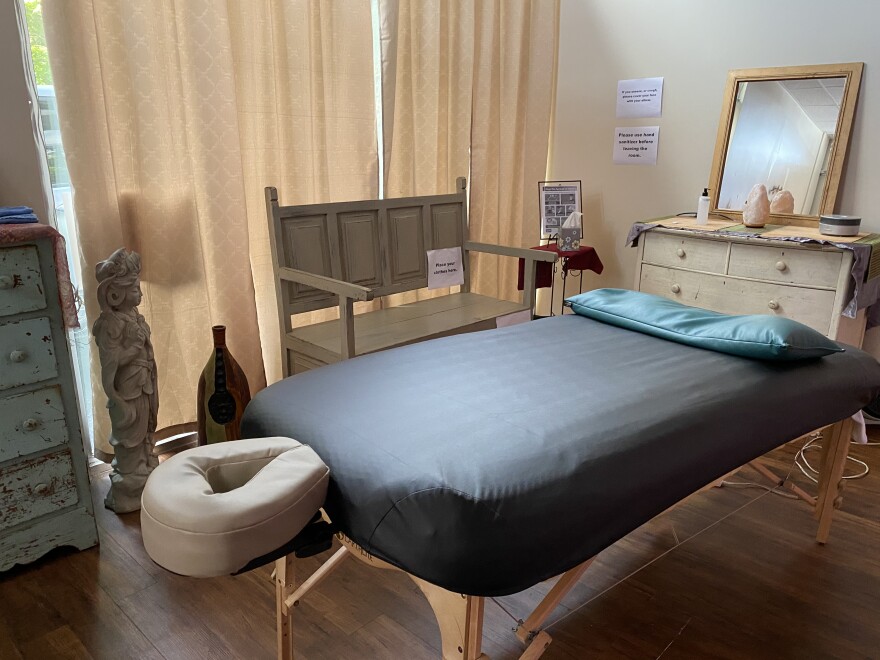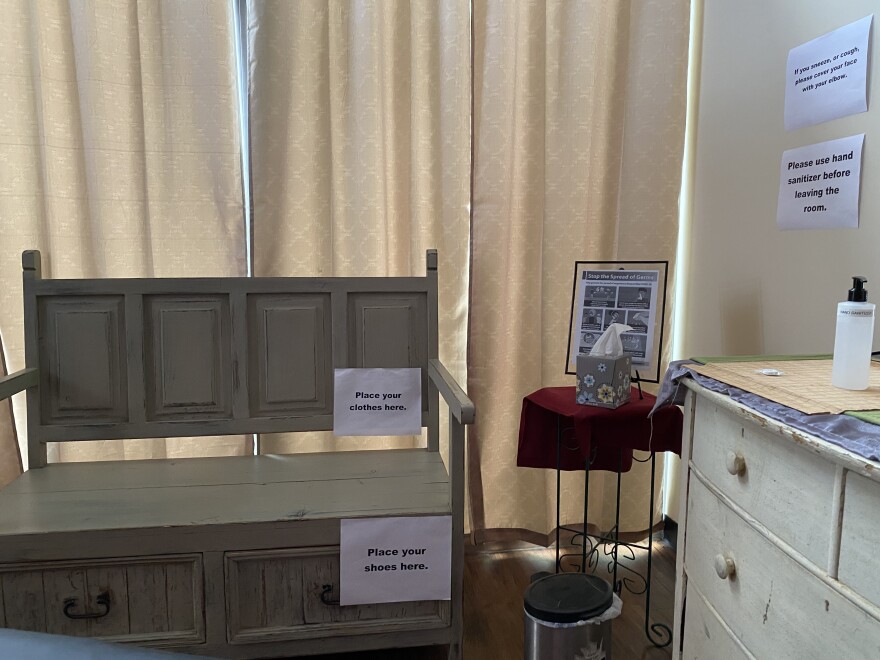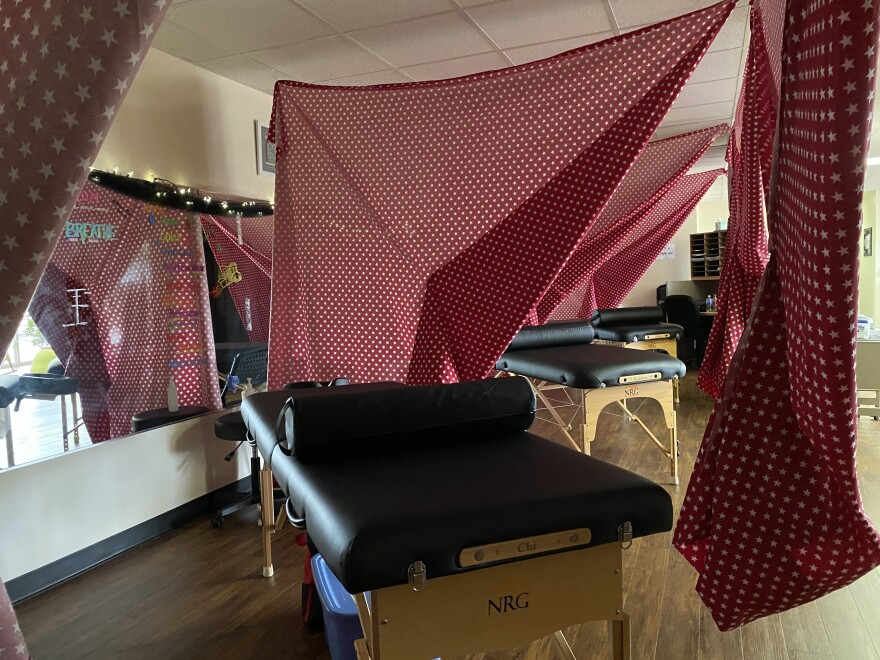Hugs and handshakes are so intricately woven into the southern culture, asking people not to make physical contact with each other has been a tough adjustment. Then factoring in limited (or no) in-person visits for those who are considered high risk for contracting the novel coronavirus, and what you have is a large number of people who are what Valerie Smothers refers to as “touch deprived.” Luckily, she and other massage therapists have been able to make adjustments to their protocols and procedures, helping to fill that void for their clients.
Smothers has been a massage therapist since 1999 and opened the Palpation Prep School of Massage in Nov. 2019 in Benton, Kentucky. In addition to educating future massage therapists, Smothers still treats her clients, some of whom have been with her since the early 2000s. She said when Governor Andy Beshear’s order forced the mid-March closure of her private practice and her school, she felt helpless.
“It was a little odd to be told that we couldn't help...that's kind of why massage therapists get into this profession, because they want to help people. And at a time when the communities need, you know, compassionate touch, we're not allowed to touch anybody and it was a little difficult,” she said. “We are very touch deprived right now. ...And now more than anything, any time in history, I think we need somebody with comforting touch.”
The majority of her client base has autoimmune diseases such as multiple sclerosis, lupus, Crohn’s Disease and rheumatoid arthritis, Smothers explained, which added to the concerns, two-fold: on one hand, she wasn’t able to treat them and assist with alleviating the many symptoms they suffer; on the other, they’re especially high-risk for catching coronavirus, so reopening meant intense precautions.

Smothers was excited when she received the invitation to join the 13-person coalition who created the requirements for safely reopening massage therapy services. As the past president of the Kentucky chapter of American Massage Therapy Association, current massage therapy school owner and massage therapist, she offered a variety of perspectives and concerns to the other coalition members who represented the industry across the commonwealth. She said some of them worked in spas and some worked in medical offices, some from rural areas and some from larger cities — all of which required a variety of safety management concerns.
The recommendations gathered from that coalition after six straight days of virtual meetings resulted in relatively simple requirements, Smothers explained: the clients have to wear a mask when they’re on their back, therapists place inverted pillow cases underneath the head rest to capture moisture droplets while the clients are face down, they’re careful not to “shake the sheets,” and the already intense cleaning procedures are now done with an equally intense sanitizing agent that requires nearly 30 minutes to dry between clients.
“So [the pillow case] almost kind of looks like a feedbag under the face cradle, which is brilliant, especially when you have clients that have drooled on the floor before. ...We accept that. It's like a standing ovation,” Smothers said with a laugh. “It's perfect. We're gonna be doing that forever.”

Smothers said the new procedures also include massage therapists screening themselves for symptoms, and screening their clients upon arrival. And each massage therapist is required to have a protocol for contact tracing, should the need arise.
But it’s really as basic as, “Keep your own juices to yourself and be a friendly neighbor,” she said.
Smothers said she doesn’t consider keeping her own juices to herself, wearing masks and frequently sanitizing a hardship, and the fear of contraction from her clients despite the close proximity isn’t at the forefront of her thoughts.
“It has made me more mindful of myself and my own body mechanics,” she explained. “Now the mask, when I'm working, if you'd asked me before what it felt like, at first it was hot. I was sweating. Then I realized that if I slow my breathing down...if I inhale through my nose, I'm bringing cool air into the mask. And when I exhale, I exhale twice as long as I inhale. So you're doing it slower and you're expressing much fewer droplets, is what that comes down to. So by regulating my own breathing, that's how I'm dealing with it.”
Smothers currently has three students enrolled at her school and their cubicles —separated by curtains —were already stationed approximately 10 feet apart, so the only procedural differences for them are wearing masks, scanning themselves and clients for potential symptoms, requiring clients to wear masks when they’re face up, and the additional sanitization methods. Smothers noted they’ll be at an advantage because they will graduate from school with those tools and training, including how to keep a new business afloat in the midst of a worldwide health pandemic, as standard practice.

And she said she’s eager to get them graduated and into their own practices because the community needs them.
“In September of 2018, in the 13 counties in western Kentucky we had 159 licensed massage therapists to cover over 310,000 people. There is absolutely no way that that number of massage therapists can help that many people. There are counties that have no massage therapists,” she explained. “I want our communities to have therapists in them. I want to make sure that massage therapy is a part of everybody's regular routine. So that they know what their body feels like, when it's working correctly so that when it's not working correctly, they feel it and they can express it.”
“If you get a massage every month. You know where your body stands every month,” she added. “The way I look at massage therapy is, I scan the body from one side to the other to look for dysfunction. Things that don't match. And those are the fun things. I tell my clients I like it when they bring me presents, things to work on to see if I can figure out how to bring things back to the homeostasis of that body. Whatever their ‘normally’ is.”
Smothers said most of her clients, who went two full months without treatment, were able to maintain pretty well during the closure period of mid-March to mid-June with stretches and exercises she prescribed. But getting them back on her table, she said, was like coming home.
“You develop a bond. I know the bodies of my clients. I know when someone is out of balance. I know how muscles are supposed to react to the massage movements that we do and listening to the body is super important.”
Smothers also put out a call for anyone in the region who might be interested in allowing her students to conduct clinicals on them, which she said often results in a massage. As she put it, her students “need bodies to practice on.”
“People that may think, ‘Oh, I don't need to go, my legs are too big,’ or ‘My calf looks funny,’ or ‘I have burn scars,’ or ‘I walk funny.’ We need you. You're the perfect people we need to assess,” she said. “We need to learn how to be problem solvers and use critical thinking skills. And that's what I want our therapists to do when they leave here, be critical thinkers, to be able to take the things that you say that are ailing you and ...work from there and make a plan.”





